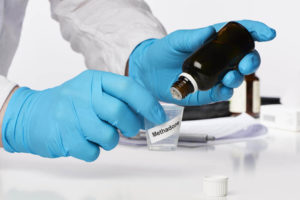For those who take Percocet to manage pain but have slowly increased their dose over time, the simplest way to handle cessation of the drug is to taper off use. Under a doctor’s supervision, the dose is decreased over time, and the symptoms associated with opioid detox are minimal. Many find they can continue with their regular tasks without interruption even if they experience headaches, body aches, or other issues related to stopping their Percocet use.
For people who have opioid use disorder, it is not always a simple process to taper off Percocet. Cravings for more of the drug, extreme withdrawal symptoms, and psychological distress may make the individual feel it is necessary to relapse or increase their dose. During tapering, general monitoring provided by a physician is recommended, including:
- Temperature, blood pressure, and pulse checks
- Drug tests to ensure that levels of opiates in the system are decreasing over time and to identify whether or not use of other drugs of abuse may be complicating the process
- Checking in with other medical professionals who are treating the client to synthesize treatment plans and avoid the prescription of opioids by another doctor
- Alternative treatment for chronic pain if the pain has continued to be an issue
If medical monitoring during the tapering process reveals there are any functional issues on any of the above points, a more supported form of detox may be recommended.
Unsupported Withdrawal Timeline
If no other factors are playing a role in how the individual experiences detox, then the timeline will be as quick as the managing physician allows. This will be influenced by the dose level at the time detox begins.
According to a person’s tolerance, the physician will likely prescribe a bump down in the dosing schedule every two to four weeks. If at any time the person wants to hold at a certain dose, that will extend the timeline. If everything is going smoothly or the person is willing to deal with some discomfort associated with Percocet withdrawal symptoms, it can be a simple, if not tedious, process.
Medication Options for Opioid Detox
In some cases, tapering off Percocet is complicated. Psychological dependence on the drug coupled with physiological dependence equals addiction, and addiction cannot be treated by simply tapering down the dose over time.
For many people, medications approved to assist someone through the process of Percocet detox can be a lifesaver, easing cravings and other withdrawal symptoms associated with opioid detox. Some medication options include:

- Methadone: Depending on the dose of Percocet at the time of detox, the dose of methadone will vary. It will take longer to taper down from higher doses, but because methadone is dispensed in liquid form for opiate detox, it is possible to very slowly lower the dose by 1 mg (milligrams) to 2 mg at a time if necessary to stave off withdrawal symptoms and remain focused on recovery. A dose of 80 mg of methadone or higher is considered a “blocking dose,” meaning that if the user were to take Percocet or any other opiate drug, they would not experience a high.
An inpatient methadone detox taper can take about a week. Outpatient and high-dose methadone detox will take weeks, if not months.
- Buprenorphine: Buprenorphine is approved by the U.S. Food and Drug Administration for use only in the treatment of opioid detox. It is the medication of choice for low-dose Percocet addiction that is not compounded by the use of other opiate drugs. Taken as a sublingual tab, buprenorphine can trigger withdrawal symptoms if taken too soon after Percocet. Inpatient use of buprenorphine can be completed in about a week. Outpatient treatment takes as long as necessary. Buprenorphine is often prescribed to help those living with high-dose opiate addiction transition from 40 mg of methadone to a less restrictive form of detox and to help others transition from active addiction to abstinence.
- Clonidine: This drug has been used to help people manage opioid addiction for more than 25 years. While clonidine is an analgesic and can ease some of the pain associated with opiate detox, it does not do as well in the management of other opioid withdrawal symptoms, including insomnia, restlessness, and others. Relapse is always a potential problem during detox. While relapse on a methadone-based detox may occur later during the process, those who use clonidine are at higher risk of relapse at the beginning of detox but may be better able to avoid relapse for the long term. There are some risks associated with clonidine use, such as hypotension, so buprenorphine is usually the preferred medication.
- Lofexidine: This medication is similar in chemical makeup to clonidine, but it does not come with the same risks of hypotension or sedation. Lofexidine is newer on the scene than clonidine, but it has demonstrated comparatively longer-lasting results. Often used in combination with other drugs to manage opioid withdrawal symptoms, lofexidine may be paired with medications designed to address the specific withdrawal symptoms a patient may be experiencing. For example, some physicians may recommend the use of low-dose naloxone with the drug to serve as a blocking agent to prevent relapse. Studies are ongoing to determine the efficacy and timeline of the use of lofexidine in combination with naltrexone for the treatment of opioid withdrawal.
Rapid Detox
Forms of rapid or ultra-rapid detox are available to treat opioid withdrawal. These forms of treatment are generally not recommended, as deaths have been associated with their use. Any use of rapid or ultra-rapid detox should be supervised around the clock by physicians.
- Naltrexone and clonidine: In some cases, physicians have used naltrexone and clonidine to assist patients in a more rapid version of inpatient opioid detox. Again, several studies have explored the efficacy of clonidine paired with naltrexone in managing withdrawal symptoms as compared to clonidine alone or at varying doses of naltrexone. There is little evidence to support the use of this combination for this purpose or to support the long-term ability to sustain recovery after this form of detox.
- General anesthesia: General anesthesia has been explored in various settings and circumstances to help people more rapidly overcome the discomfort associated with withdrawal symptoms caused by opioid detox. Essentially, the person goes through the discomfort associated with cold-turkey detox without any medications while under anesthesia. This method has proved to be ineffective in helping people find long-lasting sobriety, and it has very frequently resulted in fatalities.
The Gold Standard for Opioid Withdrawal
When it comes to determining what the safest and most effective option will be for someone undergoing Percocet detox, studies have shown time and again that a personalized approach is the best possible choice. There is no one-size-fits-all standard for supporting detox because each person who undergoes the process comes into it with a unique set of circumstances, needs, and goals. For that reason, there is no way to state exactly how long it will take to go from an active physical dependence on Percocet to being free from the drug.
“Additionally, no matter what the timeline for detox is, no treatment is complete without months of follow-up therapeutic intervention and aftercare support. Percocet addiction is more than just a physical dependence on the pills. Rather, it is also defined by psychological dependence, which must be addressed as well. Though the physical withdrawal symptoms are the focus for the first couple weeks as the person stabilizes, the main priority of addiction treatment is to address compulsive drug use and to create new patterns and choices that are healthy and sustainable in sobriety.”
How to Get Off Percocet?
How to Get Off Percocet?
Percocet addiction can have lasting consequences on a person’s life. Despite its therapeutic benefit and use for chronic pain, it can cause tolerance, dependency, and addiction. Percocet is typically prescribed on a short-term basis, but the individual using the drug might resort to illegal methods of feeding their habit. Percocet withdrawal can be severe, and without the help we mentioned above, it could cause a person to use illicit opioids, like fentanyl, to avoid the symptoms. Percocet addiction can lead to the following risky behaviors:
- Stealing
- Seeing multiple doctors to get prescriptions
- Using a fake prescription
- Seeking out drug dealers
- Stealing medication from your friends or family
Since the active ingredient in Percocet is oxycodone, there are several side effects tied to abusing the drug. The most common side effects caused by Percocet addiction include the following:
- Dizziness
- Headache
- Fatigue
- Anxiety
- Diarrhea
- Memory loss
- Abdominal pain
- Diarrhea
- Constipation
As was mentioned above, medical detox is a crucial component in the battle against Percocet addiction to combat some of the worst withdrawal symptoms. However, it’s not always enough. Detox is enough to help you clear your system of the drug, but it doesn’t touch on the underlying factors that pushed you to abuse Percocet in the first place, leading you to wonder – how do I get off Percocet?
Residential Treatment
Residential Treatment
Once you complete detox, the next step awaits you. For those struggling with a severe substance use disorder (SUD), residential treatment might be the best option for you. If you’re ready to manage your addiction and seek professional care, you could live in a facility on-site for up to 30, 60, or 90 days. It’s dependent on your wants and needs.
Residential treatment gives you the opportunity to get a break from your home life and external stressors to focus on yourself and your recovery. If you’ve relapsed in the past, it’s an ideal option. You’ll be around substance abuse professionals in a secure environment, meaning your odds of relapse are much lower.
You’re most likely to relapse early in recovery, especially if you’re going through a rut in recovery. For this reason, detoxing in a residential facility and moving into inpatient care will help you fight against this.
Intensive Outpatient Programs (IOP)
Intensive Outpatient Programs (IOP)
Some treatment centers offer an intensive outpatient program (IOP), which is a step from more intensive inpatient care. In IOP, you’ll attend a minimum of 12 hours a week to complete the program. You’ll receive similar treatment as if you were in residential rehab, but the primary difference is you’ll reside at home and commute to therapy and counseling. It allows you to gain a sense of freedom but still endure an intensive program.
Outpatient Treatment
Outpatient Treatment
Outpatient treatment is another step down from intensive outpatient treatment because it requires fewer weekly hours for treatment. It’s an ideal option for those with mild addictions or for a person who completes other treatment programs but isn’t ready to stop getting help altogether.
Generally speaking, those who commit to longer treatment regimens will have a more positive outcome. They’re less likely to give in to temptations and relapse and experience more peace and happiness. One such reason is they took a significant amount of time digging into their emotional issues and finding positive ways of solving them. With that, they learn how to apply the techniques they’ve learned in treatment to the real world.
If you’ve been battling Percocet addiction, it’s time to seek the help you need. Any of these programs are helpful in overcoming such a serious affliction.
Are You Ready to Connect with Treatment on Behalf of Your Loved One?
If your loved one is living with an active Percocet addiction and tapering off the dose under the supervision of the doctor is not working, it is time to consider substance treatment options. Speak to a substance abuse treatment professional who can help your loved one determine what type of detox will be most effective in their case.
Taking the first steps and undergoing a full evaluation with medical experts will help your loved one make an informed choice about how to build a solid treatment plan.

